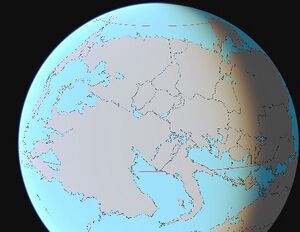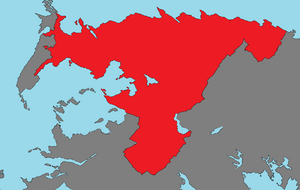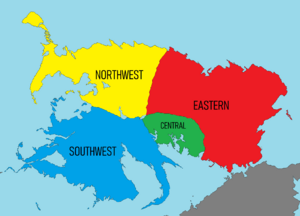Euronia: Difference between revisions
No edit summary |
|||
| Line 1: | Line 1: | ||
{{Infobox continent | {{Infobox continent | ||
|title = Euronia | |title = Euronia | ||
|image = | |image = EuroniaUpdated.jpg | ||
|area = 44,579,000 km2 | |area = 44,579,000 km2 | ||
|population = 3,200,000,000 | |population = 3,200,000,000 | ||
Revision as of 18:40, 27 September 2020
 | |
| Area | 44,579,000 km2 |
|---|---|
| Population | 3,200,000,000 |
| Demonym | Euronian |
| Countries | List of sovereign states and dependent territories (Iearth) |
| Largest cities | Tofino, Arinals, Vessalia, Lerbin, Emerald, San Beausoleil, Mönusÿnthys, Ponamu, Heimdahl'ia, Danaska, Titania, Providence, Jade Harbor |
Euronia is the largest continent located on the planet of Iearth. The vast continent is bounded by the bustling Olympic Ocean to the west, the Northern Ocean to the north, the Samson Ocean to the east, and the expansive Toyana Ocean to the south. A narrow land bridge connects Euronia to Ausiana through the country of Vulkaria, though it is bisected by the Vulkarian Pass.
Euronia is home to some of the most influential nations in the world both in terms of historical impact and modern day connection, including Zamastan, Gladysynthia, Drambenburg, Vulkaria, and the Dominion of the Sanguine Church.
Etymology
History
Pre-Euronia period
Middle Ages period (1-1500 AD)
Over time, indigenous cultures in Zamastan grew increasingly complex, and some, such as the Catica First Nations (Kelowna) culture in the northwest, developed advanced agriculture, grand architecture, and state-level societies. The Kelowna culture flourished in the south from 800 to 1600 AD, extending from the Gladysynthian border down through Rio Palito. Its city state Kelowna is considered the largest, most complex pre-historical archaeological site in modern-day Zamastan.
In the east, the Kingdom of Mayotte formed with the collective federations of other kingdoms in 1200 AD. The Second Drambenburg Empire and the Kingdom of Mayotte fought the Fifty Years War from 1337-1389 due to each side claiming legitimate power over the palatinate of Aunistria. Aunistria was ultimately conquered by Drambenburg.
Modern period (1500-present day)
Growth of Empires
In 1670, the seven provinces of Gladysynthia combined to create the Gladysynthian Empire, which expanded into a large regional powerhourse of Northern Euronia, governing areas in Baytonia and Llihc. Much of current day Jade was also part of Gladysynthia, but upon Zamastan's founding, they purchased the territory in 1824.
In the late 17th and 18th century, the Empire of Skith took over vast swaths of southwestern Euronia in what is current day Zamastan, Gladysynthia, Ruskayn, Rio Palito, and Ossinia. In 1804, the country of Zamastan was formed following the victory of rebel forces in the Zamastan War of Independence, and this event marked the downfall of the Skith Empire on Euronia.
The Empire of Paraboca conquered Chanchajilla (East and West), also extended their territory into northern Drambenburg, Avergnon, and Mayotte. The subsequent Great Cardoza War in which Zamastan was initially invaded and eventually pushed back the imperial forces, resulting in extensive infighting, rebellions, and economic instability, Paraboca's empire collapsed.
Avergnon had a moderate-sized regional empire located along the coast and lowland regions of Siena Bay on the Toyana Ocean, which eventually expanded into the Avergnon highlands and modern day Tinten through Lewis Pontegnone's conquests in the 1700's. Vessalia became a regional powerhouse, trading with other imperial cities such as Cardoza and Vilanja. Several devestating wars throughout the centuries with Drambenburg prevented either side's larger expansion into each other's territory.
Rise of Nationstates
Geography
Regions
Euronia, due to its immense size, is generally divided into four subcontinental categories: Eastern, Central, Northwest, and Southwest. These are generally categorized by geographical features. The Northwest is defined to the south by the Danaska River and the Great Southern Mountain Range and to the east by the Great Eastern Mountain Range in Llihc, Paraboca, and Gladysynthia. The Southwest is defined by the Zamastanian subcontinent and Drambenburg, with the Central consisting of the expanse of the Siena Bay countries stretching from Avergnon to Jefferson. The Eastern subcontinent is largely flat plains and prairie land with isolated forest and mountain ranges, building up into the Great Eastern Mountain Range.





